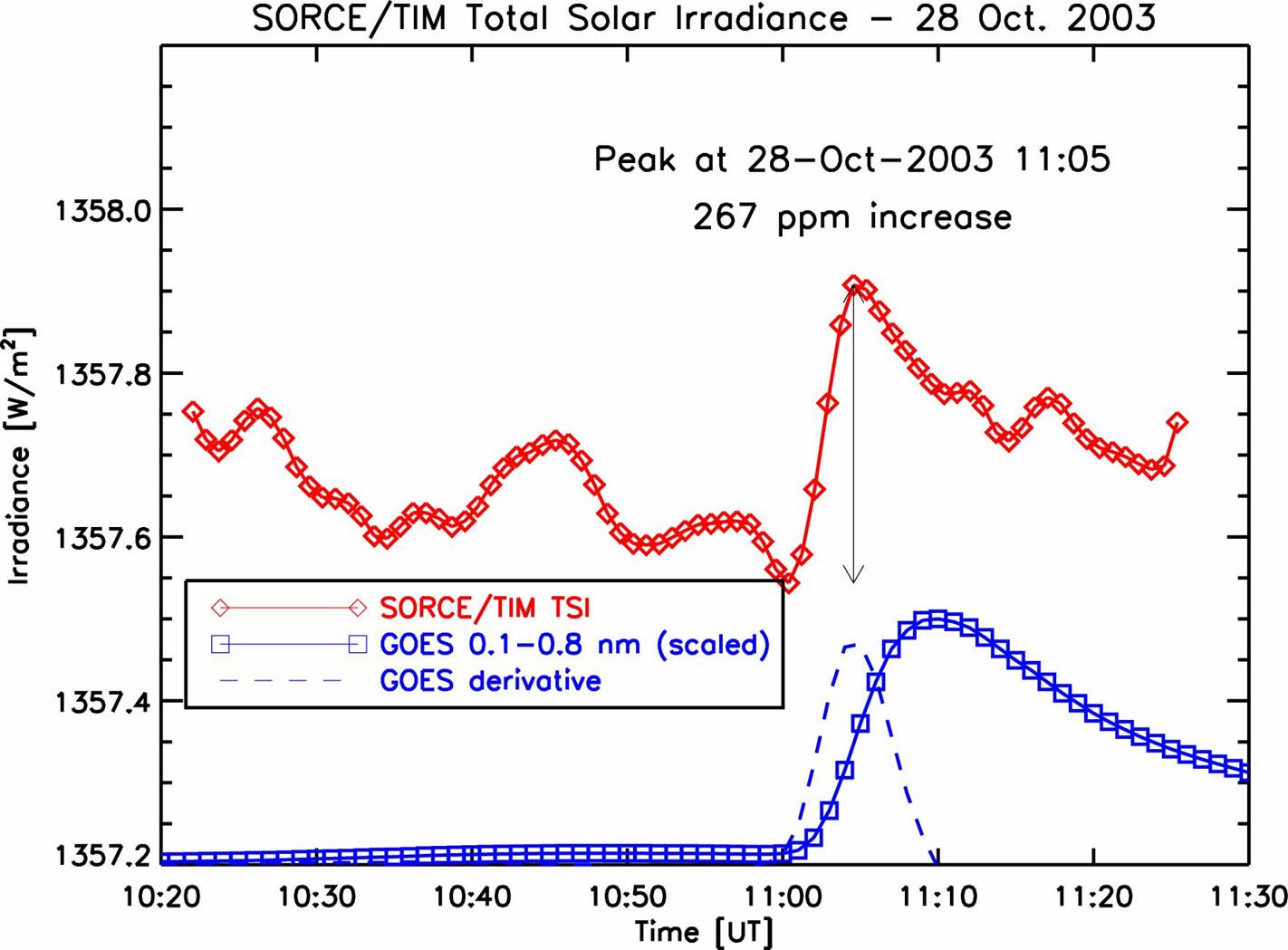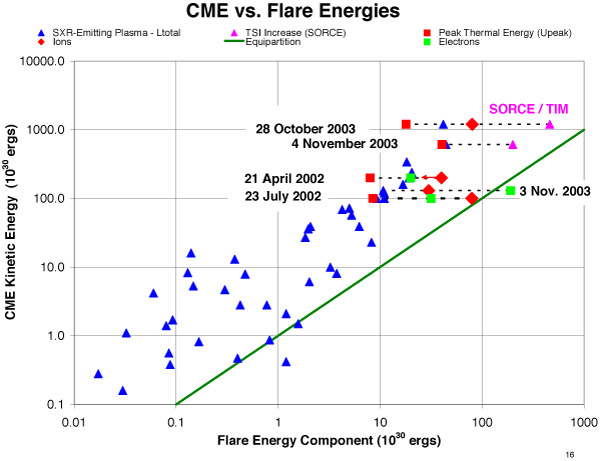Introduction
Solar flares are the brightenings ("eruptions" in older terms)
we see near the surface of the Sun; CMEs (Coronal Mass Ejections)
are the huge clouds of gas ejected by the Sun through the corona and into
interplanetary space.
Soon after the earliest detections of CMEs in the 1970s, the conventional
wisdom was that a CME carried far more energy than was released
during its associated flare. The biggest flare was thought to release
no more than ~1032 ergs, whereas a CME could carry 1033
ergs or more in the kinetic energy of the material ejected from the Sun.
Although
Lin and Hudson
made the claim in 1976 that a flare released
enough energy to drive the associated CME, this was never generally
accepted, especially after 1993 when
Gosling exposed what he called the
"Solar Flare Myth."
He argued that scientists had been wrong in believing
that solar flares were the source of the main effects of solar
activity on the Earth and its environs - the magnetic disturbances,
the high-energy particles, etc. He showed that these were, in fact,
caused more directly by the CME's effects, rather than the flare.
The pendulum thus swung in the other direction.
NASA's
"Living With a Star"
program is predicated on the fact that CMEs are the
most important aspect of solar activity affecting the Earth and
interplanetary space. Most of the resources are being spent on
understanding CMEs, how they are produced, how they propagate to
and interact with the Earth, how they accelerate the solar energetic
particles. The solar flare has apparently been reduced to a secondary role as
a scientifically interesting phenomenon but one of little consequence
energetically.
SORCE Total Solar Irradiance Measurements
Recent new observations and analysis have suggested that this belief
that the CME carries most of the energy may itself be wrong.
These observations show that the energy released in a flare is not
inconsequential and, in fact, may be comparable to the kinetic energy
of the material of the associated CME.
The best indication that this may well be
the case is the first-ever detection of an increase in the
total solar irradiance (a.k.a. "solar constant")
made with instrumentation on the
SORCE mission
(see Figure 1). On October 28, 2003, the Total Irradiance Monitor
(TIM)
on SORCE detected an increase in the total solar irradiance at the
time of a huge X17 flare recorded by the X-ray monitors on
GOES.
The estimated total radiated
energy during the flare was 4.6 x 1032 ergs with an uncertainty of
no more than 50%. The estimate of the CME kinetic energy determined
from LASCO observations was 1.2 x 1033 ergs, i.e. much less than an
order of magnitude larger than the flare's radiated energy.

Figure 1. Total solar irradiance measured with SORCE for the
X17 event on 28 October, 2003.
Also shown are the GOES light curve and its time derivative.
The increase in the radiated energy seen by SORCE provides the most
reliable lower limit on the energy released in a flare ever determined.
There can be little doubt that the measured increase in the radiated
energy all came from the flare and was part of a generally isotropic
emission pattern. With those simple assumptions, it is
inescapable that the flare released a minimum of that much energy.
Of course, additional flare energy may not have been detected with
SORCE. For example, accelerated particles may have escaped from the Sun.
Also, all of the flare energy may not have thermalized and radiated away during
the SORCE observations but these would only increase the estimate
of the total energy released by the flare. Thus, the conclusion
that the flare and CME energies are comparable seems unavoidable
for this event at least.
Observations of two large eruptive events
How could solar scientists have been so wrong again?
Even the early analysis of RHESSI observations had seemed to support
the "flare myth", i.e. that flares are weaker than the associated CMEs.
Emslie et al. (2004)
had reached the "cautious conclusion" based on the
analysis of RHESSI and LASCO observations of two large eruptive
events in 2002 that the CMEs are more energetic than the associated flares.
A re-examination of the observations in light of the SORCE result
carried out by
Emslie et al. in 2005 revealed that perhaps that
conclusion was not cautious enough. Perhaps it was just plain wrong.
They showed that if the estimated thermal energy in the hot plasma
(T>5 x 106 K)
that produced the soft X-rays seen with GOES and RHESSI
were scaled by the same factor of ~100 found for the SORCE event,
then indeed the flare and CME energies were comparable for the two
events studied. Moreover, the energy in flare-accelerated electrons
and ions determined from RHESSI's hard X-ray and gamma-ray measurements,
respectively, was greater than the energy in the thermal plasma.
This suggests that these particles must generate cooler plasma
(T<5 x 106 K) when they thermalize and that the radiation from this
plasma is detectable by SORCE but not by GOES or RHESSI. In this
connection, it may be significant that the SORCE-measured increase
in total solar irradiance actually peaked prior to the GOES peak
in soft X-rays, just when the accelerated particles were at their
maximum intensity (the "impulsive phase" of the flare).
Observations of 50 eruptive events
More recent analysis of some 50 eruptive events, each with both a
flare seen with RHESSI and GOES and a CME seen with LASCO have been
analyzed to determine the total energies of the flares and the CMEs.
Dennis et al. (2005) chose a homogeneous set
from the three active regions that produced all of the intense
activity during the 3-week period from 19 October through 5 November
2003, including 12 X-class flares and perhaps the largest flare
ever recorded, the X28 flare on 5 November. For each event, the
kinetic energy of the CME was determined from the LASCO images
and the flare energies were determined
from GOES and RHESSI observations. Initially, for each event, the
total radiated energy from hot plasma (T>5 x 106 K) was calculated
from the temperature and emission measures derived from the
GOES soft X-ray observations by using the most modern information
about the state of the solar plasma.
These values are plotted as a function of the kinetic energy of the corresponding
CME in Figure 2. We see that there is a general correlation with a
scatter of less than an order of magnitude, significantly less
scatter than has been obtained in previous correlation plots of
this type. However, the flare radiated energies calculated in this
way are generally one to two orders of magnitude below the CME energies.
Before the SORCE observation, we would probably have stopped there
and concluded that the flare energy was insignificant compared to
the CME energy. However, if we use the same factor of ~100 between
the radiated energy measured with SORCE and the radiated energy
from the hot plasma measured from GOES data, then we see that the
flare and CME energies are comparable with a scatter of about an
order of magnitude.

Figure 2. CME kinetic energy derived from LASCO images plotted
against the energy of various components of the associated flares
as indicated. The diagonal line is the line of equality between the
CME and flare energies.
Support for this scaling factor of 100 comes from the RHESSI
observations that show particle energies in excess of these thermal
energies by an order of magnitude or more. This has been suspected
since SMM days in the 1980s but
new RHESSI results have lent more
credence to this conclusion. Some of
these particle energies are plotted in Figure 2 for the larger
events seen with RHESSI to show this effect. We see that for the
23 July flare, in particular, the energy in ions estimated from the
RHESSI gamma-ray measurements is itself almost identical to the CME
kinetic energy for that event. Thus, it seems clear that at least
for the larger events with fast CMEs and associated flares, the
total energies of the two components are comparable in magnitude.
Conclusions
In retrospect, it may not be surprising that flare and CME energies
are comparable. In the simplest model of these eruptive events, the
energy is released in the corona by magnetic reconnection, with the
material going up becoming the CME and the material going down
making the flare. Equipartition of energy going up and going down
might be expected in such a scenario. Of course, the situation is
obviously much more complicated than such a simple-minded model
would suggest. However, it is clear that the origins and energy
sources of flares and CMEs are so intimately entwined that it is
impossible to explain one without understanding the other. This is
especially true now we know that flares are likely to be just as
big energetically as CMEs.
Biographical note:
Brian Dennis is a solar physicist at NASA's Goddard Space Flight
Center, and is the RHESSI Mission Scientist and a CoI.


